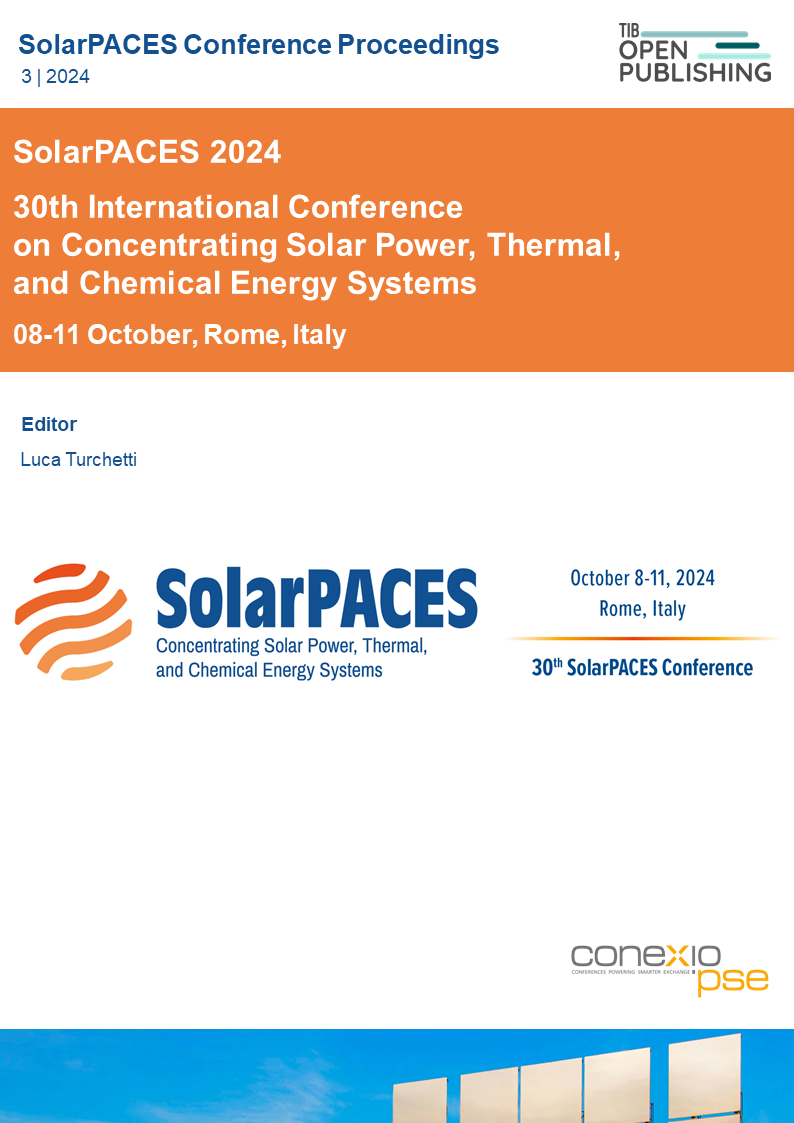Hybrid Concentrated Solar Thermal and Wind Resistive Heating Systems as Key for Competitive Low Emission Industrial Process Heat Generation
DOI:
https://doi.org/10.52825/solarpaces.v3i.2327Keywords:
Process Heat, Solar Thermal, Hybridization, Energy System, DecarbonizationAbstract
Concentrated Solar Thermal (CST) has been addressed as a promising technology for industrial heat decarbonization; however, its use is still limited to low-medium temperature processes (50-250°C). The following analysis explores its feasibility at high temperature employing a parabolic trough solar field with a direct two-tank storage configuration using molten salts both as heat transfer fluid and storage medium, to provide a constant 10 MWTH power to heat up a process fluid to 500°C. Through an economic optimization, various levels of process decarbonization are examined, also including CST hybridization with resistive electric heating powered by photovoltaic and wind energy generation and computing CO2 emissions on a life cycle assessment (LCA) basis. The results indicate that CST is a viable alternative to direct electrification up to 30-50% process decarbonization, while hybrid systems show potential to reduce costs up to 40% at high decarbonization levels. Moreover, although achieving 100% process decarbonization remains still unfeasible, decarbonization levels up to 80-95% appear economically viable when considering up-to-date costs and the forecasted carbon tax.
Downloads
References
[1] IEA (2018), Clean and efficient heat for industry, IEA, Paris https://www.iea.org/commentaries/clean-and-efficient-heat-for-industry.
[2] C. Schoeneberger, C. McMillan, P. Kurup, S. Akar, R. Margolis, E. Masanet, “Solar for industrial process heat: A review of technologies, analysis approaches, and potential ap-plications in the United States”, Energy, Volume 206, 2020, https://doi.org/10.1016/j.energy.2020.118083.
[3] European Commission, EU ETS, https://climate.ec.europa.eu/eu-action/eu-emissions-trading-system-eu-ets_it (Accessed July 26, 2024).
[4] O. Marzouk, "Land-Use competitiveness of photovoltaic and concentrated solar power technologies near the Tropic of Cancer", Solar Energy, Volume 243, 2022, Pages 103-119, https://doi.org/10.1016/j.solener.2022.07.051.
[5] IRENA (2021), Renewable Power Generation Costs in 2020, International Renewable Energy Agency, Abu Dhabi.
[6] M. D’Auria, M. Lanchi, R. Liberatore, “Selezione delle configurazioni di sistemi solari a concentrazione idonei alla fornitura di calore di processo per diversi settori applicativi in-dustriali ed elaborazione di schemi concettuali di integrazione”, 2019, ENEA.
[7] T. Huld, R. Müller, A. Gambardella, "A new solar radiation database for estimating PV performance in Europe and Africa", Solar Energy, Volume 86, Issue 6, 2012, Pages 1803-1815, https://doi.org/10.1016/j.solener.2012.03.006.
[8] I. Staffell, S. Pfenninger, “Using Bias-Corrected Reanalysis to Simulate Current and Fu-ture Wind Power Output”. Energy 114, pp. 1224-1239, 2016, https://doi.org/10.1016/j.energy.2016.08.068.
[9] System Advisor Model Version 2023.12.17 (SAM 2023.12.17). National Renewable En-ergy Laboratory. Golden, CO. Accessed July 26, 2024. https://sam.nrel.gov/download.html
[10] M. Wagner, «SAM Webinar: Modeling Parabolic Trough Systems,» NREL, 2014.
[11] M. Wagner, «SAM Webinars: Modeling Molten Salt Power Tower Systems,» NREL, 2017.
[12] E. González-Roubaud, D. Pérez-Osorio, C. Prieto, "Review of commercial thermal ener-gy storage in concentrated solar power plants: Steam vs. molten salts", Renewable and Sustainable Energy Reviews, Volume 80, 2017, Pages 133-148, https://doi.org/10.1016/j.rser.2017.05.084.
[13] G. Glatzmaier, “Developing a Cost Model and Methodology to Estimate Capital Costs for Thermal Energy Storage”, NREL, 2011.
[14] J. Pérez, A. Jaramillo, M. García, J. Cardemil, R. Escobar, "Techno-economic analysis of hybrid solar thermal systems with flat plate and parabolic trough collectors in industrial applications", Alexandria Engineering Journal, Volume 86, 2024, https://doi.org/10.1016/j.aej.2023.11.056.
[15] IRENA (2024), Renewable power generation costs in 2023, International Renewable En-ergy Agency, Abu Dhabi.
[16] NREL (National Renewable Energy Laboratory). 2022. "2022 Annual Technology Base-line." Golden, CO. https://atb.nrel.gov/electricity/2022/utility-scale_battery_storage
[17] D. Stack, D. Curtis, C. Forsberg, "Performance of firebrick resistance-heated energy storage for industrial heat applications and round-trip electricity storage", Applied Energy, Volume 242, 2019, Pages 782-796, https://doi.org/10.1016/j.apenergy.2019.03.100.
[18] GME, «Gestore Mercati Energetici,» [Online]. Available: https://www.mercatoelettrico.org/it/.
[19] Eurostat, Electricity prices for non-household consumers, accessed: 12/7/24, https://ec.europa.eu/eurostat.
[20] BloombergNEF, EU ETS Market Outlook 1H 2024: Prices Valley Before Rally, (ac-cessed: 08/08/24) https://about.bnef.com/blog/eu-ets-market-outlook-1h-2024-prices-valley-before-rally/.
[21] solarthermalworld.org, “Solar Thermal Shows Highest Energy Yield Per Square Metre”, accessed: 19/05/25, https://solarthermalworld.org/news/solar-thermal-shows-highest-energy-yield-square-metre/
[22] M. Bolinger and G. Bolinger, “Land Requirements for Utility-Scale PV: An Empirical Up-date on Power and Energy Density,” IEEE J Photovolt, vol. 12, no. 2, pp. 589–594, Mar. 2022, doi: 10.1109/JPHOTOV.2021.3136805.
[23] S. Ong, C. Campbell, P. Denholm, R. Margolis, and G. Heath, “Land-Use Requirements for Solar Power Plants in the United States,” 2013. [Online]. Available: www.nrel.gov/publications.
Published
How to Cite
Conference Proceedings Volume
Section
License
Copyright (c) 2025 Marco Colombi, Paolo Colbertaldo, Matteo Carmelo Romano, Marco Binotti

This work is licensed under a Creative Commons Attribution 4.0 International License.
Accepted 2025-06-02
Published 2025-10-22
